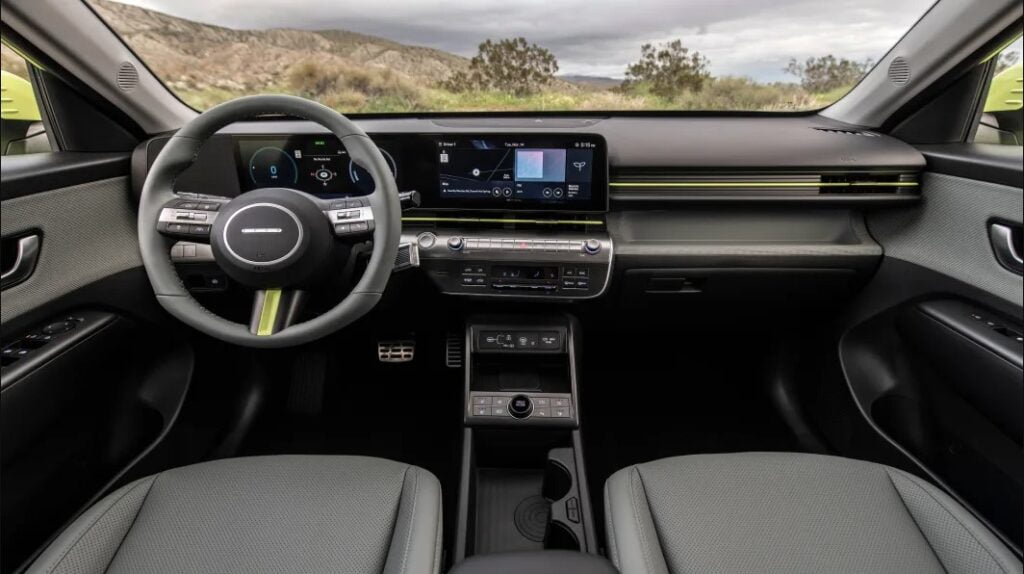
At the end of last year, Hyundai showed off the design of its 2024 Kona, but today, as the new Kona makes its North American debut at the New York Auto Show, Hyundai is giving us all the US specs.
This new age of Kona begins with the electric model (found in yellow above), as Hyundai says it fostered another stage with the electric model as the need. It has a battery capacity of 64.8 kWh, which Hyundai claims gives it 260 miles of range. The EPA hasn’t yet released numbers, but the 2023 Kona Electric is rated at 258 miles. For this generation of Kona Electric, there will also be a smaller 48.6 kWh battery pack with 197 miles of range. This is the first time Hyundai has offered two different packs for the Kona Electric.
In contrast to the E-GMP platform’s 800-volt architecture, Hyundai’s new Kona platform still uses 400 volts. As a result, charging speeds are comparable to those of the previous model. In ideal conditions, Hyundai claims a charge time of 43 minutes and an efficiency of 10% to 80%, but it does not specify a maximum speed. Similar to other Hyundai/Kia EVs, it will also be capable of vehicle-to-load, but its power output will be limited to 1.7 kW.

The Kona Electric’s only front-wheel-drive configuration remains despite the battery pack. The large battery pack rendition has a solitary electric engine really great for 201 pull and 188 pound-feet of force. That has the same amount of power as the previous model, but it has significantly less torque than the 2023 model, which had 291. A motor with a lower output of 133 horsepower and 188 pound-feet of torque powers the Kona’s small battery.
If you’d prefer the gas-powered Kona (shown above), Hyundai has two different powertrain choices for you to choose from. The first is a 2.0-liter four-cylinder with 147 horsepower and 132 pound-feet of torque, which is a carryover. It is standard and is paired with a continuously variable transmission. In the interim, the N Line and Restricted manages to get a 1.6-liter turbocharged four-chamber that makes 190 pull and 195 pound-feet of force. An eight-speed automatic transmission is used with this motor, and it should be much more fun than the CVT in the base model.
Both front-wheel drive (FWD) and all-wheel drive (AWD) models will be available, and we believe that the multi-link rear suspension of the AWD models makes them slightly more comfortable to drive than the FWD models, which have to make do with a torsion beam rear axle. The Kona Electric, on the other hand, stands out because it is front-wheel drive and a multi-link rear suspension. While the N Line will not improve performance, it will have distinctive 19-inch wheels, redesigned front and rear fascias, an aggressive rear spoiler, and dual exhaust. The additional sportiness extends to the interior as well, which features aluminum sport pedals and red scuff marks all over the N Line scuff plates.

Because the Kona is now a larger vehicle than it was in the past, the interior of all Kona models has been completely redesigned and is significantly more spacious. Overall, the Kona is 5.7 inches longer and an inch wider than the previous model, providing more space for cargo and passengers in the backseat. To free up some storage space, the gear lever moves from the center console to the steering column. In addition, Hyundai claims that the 12.3-inch screens—the same size as the infotainment system and cluster—will run next-generation software, which we are eager to test out.
Additionally, Hyundai’s Digital Key 2 Touch, which lets you use your smartphone as a key, OTA update-capable infotainment, remote smart parking, and a lot more driver assistance features like Blind-Spot View Monitor and the consistently excellent Highway Drive Assist is among the notable technological enhancements.
The new Kona doesn’t yet have a price, but Hyundai says dealers will get the version with a combustion engine this summer. In the late fall, Kona Electric will closely follow.







